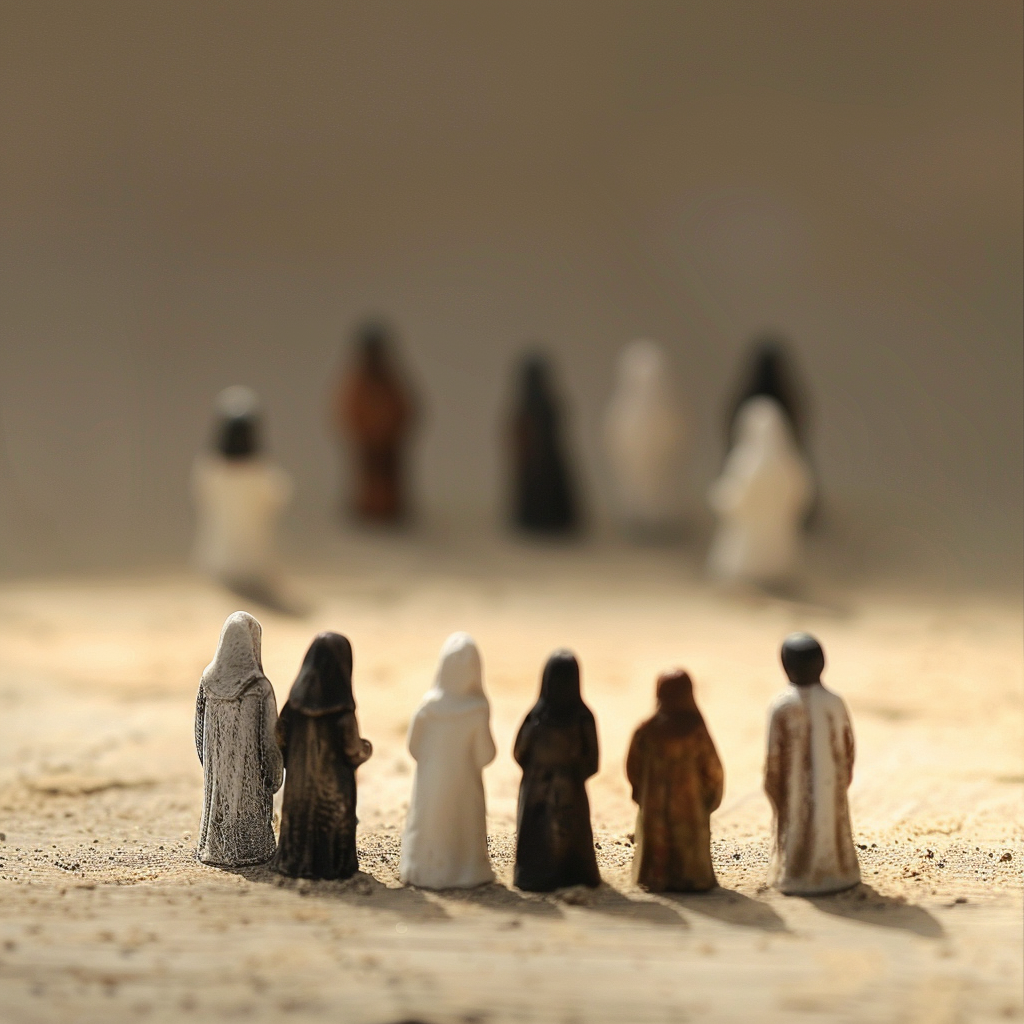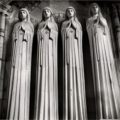The role of the community in religions: Refuge or dungeon
- The role of the community in religions: Refuge or dungeon
- Introduction
- Internal inclusion and exclusion
- External inclusion and exclusion
- Inclusion and exclusion – roots
- Sangha in Buddhism
- Monotheism
- Psychological effects on children
- 1. Uncertain sense of belonging
- 2. Split self-perception
- 2. Fear of punishment and isolation
- 3. Devaluing self-perception
- 4. Impairment of social development
- 5. Trauma through physical and emotional punishment
- Therapeutic approaches
- Exercises for self-help
- Conclusion
Introduction
In the “Religion and Childhood Trauma” series, we have previously explored how deeply religious beliefs and practices intervene in children’s early development and psychological well-being. So far, it has been about:
Inclusion and exclusion are dynamic processes, not only in religious communities, which influence both the internal structures of these communities and their relationships with the outside world. These processes operate on several levels and have far-reaching psychological, social and cultural effects.
Internal inclusion and exclusion
- Identity and cohesion
Within religious communities, inclusion fosters a strong sense of belonging and identity. Members who follow the beliefs and practices often feel secure and affirmed as part of a larger unit. Shared rituals and beliefs strengthen this sense of community and internal cohesion. If individual members or groups are seen as non-conforming or deviating from the established norms, some communities react with social isolation, segregation or even exclusion from the community.
- Power and control
In many religious communities, access to certain privileges, positions or forms of knowledge is regulated. It is then dependent on membership of an elite or hierarchically higher group. That confirms power structures within the community and the authority of leaders or elites. Exclusion from certain activities, rituals or decision-making processes also supports power and control.
External inclusion and exclusion
- Interaction with the outside world
Religious communities that open up to the outside world promote a positive image in society. The inclusion of external individuals or groups reduces reservations towards the inviting community.
Other communities choose an exclusionary or isolationist path, seeking little interaction with outsiders or even actively avoiding them. Such communities fuel mistrust of outsiders and social developments. In the public’s perception, isolation brings communities closer to sects, aloofness, hostility or backwardness. Tensions and conflicts with the outside world or authorities are often the result.
- Isolated members
If a religious community isolates its followers from the outside world and imposes a strict separation from the outside world on its adult members or even encourages them to be suspicious and hostile towards non-members, feelings of being at the mercy of others, fear and insecurity are unavoidable. In particular, threats associated with contact with the outside world – such as exclusion – fuel fear among isolated members.
Isolation in religious communities traumatises in a second way, namely when an individual is “cut” within a religious community against the backdrop of separation from the outside world.
Levi-Strauss describes in detail how a tabooed member of the community actually dies through a complex ritual of social ostracism. Such an individual, who is considered cursed or possessed by malevolent forces, is absolutely ostracised in the community and is regarded as already deceased or even as a threat to the well-being of his fellow human beings. This isolation is reinforced by various behaviours of the community, e.g. by denying contact and treating the isolated individual as non-existent, emphasising their inevitable death.
Initially, the taboo member is abruptly separated from family and social ties and excluded from participating in community activities that have strengthened their self-esteem. This drastic separation from familiar points of reference subsequently increases the individual’s anxiety and reinforces the feeling of impending doom. The sudden loss of these structures, combined with the expulsion from the community, intensifies the individual’s experience of terror and culminates in complete hopelessness. Ultimately, this collective behaviour triggers a change in perception in which the individual is transformed from a living, contributing member of society to a condemned being with no place among the living or in direct social interaction. Rituals and practices of isolation and condemnation set in motion a process of social death for the tabooed member, leading to his symbolic and social demise within the community and eventually even to his physical demise.
This description illustrates the power of boundaries of belonging to a community when declared taboo, individuals are ritually expelled and eradicated from the social fabric.
Anyone who is irrevocably excluded from a religious community in the Western world experiences a similar, total loss of social support, cohesion, meaning and purpose in life – the so-called religious trauma. They are then forced to reconstruct reality entirely and, simultaneously, are left to their own devices, especially if family and friends remain in the religion.
Inclusion and exclusion – roots
The dialectic of inclusion and exclusion in religions is already reflected in the patterns of early myths. They often show a clear symmetry between opposites that exclude each other but simultaneously include each other to form a whole. It is closely linked to the symmetrical patterns religious systems use to explain the world. These structures reflect and reinforce a community’s social and cultural dynamics by defining boundaries between what lies within and outside these boundaries. Myths shape world views and normative social orders that regulate coexistence within a community.
Creation myths: Many creation myths tell of an original separation of chaos into ordered opposites, such as heaven and earth, land and sea, light and darkness, upper world and underworld. This separation of initially united opposites represents the fundamental order of the cosmos and creates its structure for all eternity. Concerning humans, these opposites also give rise to belonging and inclusion (for example, in the upper world or the land, life) and exclusion (such as the underworld or the sea or areas depicted as dangerous and uninhabitable).
Ritual transitions: Rituals described in myths often contain elements of inclusion and exclusion, such as initiation rites that mark the transition from childhood to adulthood. The dialectic of inclusion and exclusion then marks individual transitions: inclusion in one social group and exclusion from another. These transitions are thus structured symmetrically, for example, through the phases of separation from the community with exclusion from the old group, transformation and reintegration into the community through inclusion in the new one.
The associated rituals are also both inclusive, in that they admit tested members into the adult community, and exclusive because they initiate them into secrets that remain closed to others. The transformation from a good-for-nothing to a cultural hero also takes place in the field of tension of such duality.
Myths offer explanations for the emergence of reality and its order, which is supported by symmetrical opposites such as day/night or order/chaos. The symmetry of inclusion and exclusion in myths is rooted in the search for order and meaning in human experience and, therefore, divides reality into comprehensible, opposing categories. The incomprehensible becomes comprehensible and allows the individual a sense of control or understanding of the environment.
Myths and religious narratives not only served as entertainment or spiritual enlightenment but were also essential instruments for constructing and communicating social reality. The dual structures depicted in myths reflect a society’s deepest values and fears. By showing what is acceptable (inclusion) and what is forbidden (exclusion), they guide the behaviour of community members and strengthen cultural identity. These definitions are not merely abstract but are reflected in rituals, laws and social norms in the community’s daily life.
The depiction of idealised behaviour and the consequences of non-conformity provides models for desirable behaviour and warns of the consequences of breaking taboos. In this way, individuals understand and accept their role within the community. The symmetrical patterns in myths thus reinforce social order. By telling stories showing clear contrasts and complementary relationships, social hierarchies and roles are justified and perpetuated.
Overall, the dialectic of inclusion and exclusion in the myth structure is the basis of both individual and collective identity. Boundaries, through spatial, social or moral categories, enable communities to strengthen their cohesion and simultaneously define and often ward off the foreign or other.
Sangha in Buddhism
The Sangha is the community of Buddhist spiritual practitioners who come together to support, teach and practise. The Sangha enables practitioners to meditate together, practise mindfulness, and follow the path of Buddhism. It is one of the three jewels (models) of Buddhism: the Buddha (as the teacher), the Dharma (as the teaching) and the Sangha (as the community of believers), through whose acceptance one embraces Buddhism.
The Sangha in Buddhism, therefore, represents an inclusive spiritual community that promotes personal growth. This structure of the Sangha can maintain community without isolating members or separating them from society by teaching principles such as the Four Noble Truths and the Eightfold Path as the path to enlightenment.
In addition, the Sangha fosters deep connection and unity among its members through Buddhist meditation techniques. By practising together and sharing experiences, the members of the Sangha create a supportive and loving environment that enables personal growth without isolation within the community or in the outside world. On the contrary, humanistic values such as compassion, tolerance and respect, aimed at the salvation of all living beings, characterise internal and external relationships – as bridges to other communities and society as a whole.
Monotheism
With its emergence, monotheism was forced to distance itself from the older religions of its region of origin.
It is debated whether the cult of Aton during the reign of the Egyptian pharaoh Akhenaten (ca. 1353-1336 BC) was really a case of monotheism. He placed the worship of Aton, the sun disc, above all other gods. It meant a radical departure from the traditional Egyptian polytheistic religion. Still, it would be more of a form of monolatry, i.e. the old gods remained in their place, but only Aton was worshipped. After Akhenaten’s death, his reforms were reversed anyway, and Egypt returned to its traditional gods.
One of the earliest and most significant transformations towards monotheism occurred in the context of the ancient Israelite religion. Initially, the ancient Israelites also practised a form of monolatry and worshipped Yahweh as their national God. Over time, this belief developed into a strict monotheism, especially during and after the Babylonian exile (6th century BC), in which Yahweh was seen as the only God of Israel and the only God at all.
The development of Christianity and Islam subsequently played a decisive role in the spread of monotheism. Christianity adopted and adapted the Israelite monotheistic faith, becoming a dominant religion in the Roman Empire and later in Europe. Islam, founded in the 7th century AD by the Prophet Mohammed, emphasised the unity of God (Allah) and spread rapidly in parts of Asia, Africa and later in Europe.
Philosophical and theological considerations also influenced the move towards monotheism in many cultures. The notion of a single, ultimate principle or God often offered a more straightforward and more philosophically coherent explanation of the universe, its origins and its order. This exclusion of the older polytheistic or totemic belief systems of the tribes led to vigorous isolationism within the new monotheistic communities. As a result, the Abrahamic religions – Christianity, Judaism and Islam – have historically shown a strong tendency towards isolationist group-think both internally and externally.
However, sharp demarcation has also led to schisms and the formation of sects within the monotheistic communities, in which groups have split off from the religious community as a whole, whether due to different interpretations of ethical principles, ritual practices or theological interpretations.
On the other hand, numerous movements and interpretations in history have endeavoured to mediate between the monotheistic belief systems, such as between the Eastern Church and the Western Church and between Christians and Muslims.
One famous example is the dialogue between Francis of Assisi and Sultan Al Malik Al Kamil in Damiette in the 13th century during the Fifth Crusade. Although this dialogue also ultimately failed, it is still considered perhaps the most important interreligious encounter of all. According to historical sources, the meeting between the two men was characterised by mutual respect. However, it did not result in any kind of “conversion”, as various contributions to the conference revealed. The Sultan is said to have received the Christian from Assisi with honour and listened to him with pleasure. However, although the Sultan was impressed by Francis’ personality, both participants in the dialogue remained loyal to their position. Nevertheless, their meeting showed that it is possible to meet as brothers across denominational boundaries.
Psychological effects on children
For children, the tension between inclusion and exclusion in religious communities can be a source of severe emotional and psychological trauma. It influences the development of children in many ways, from the shaping of their social identity to their understanding of security and acceptance within their community.
1. Uncertain sense of belonging
Children who grow up in an environment where a strict distinction is made between “belonging” and “not belonging” can develop a profound sense of insecurity about their sense of belonging due to self-doubt.
2. Split self-perception
They are often faced with the dilemma of harmonising their identity with the group identity. That can be particularly problematic if the children’s self-perception, behaviour, personal beliefs, or characteristics conflict with the community’s norms. Such conflicts can lead to inner tensions, identity crises and, in extreme cases, dissociative disorders.
2. Fear of punishment and isolation
In such religious communities, children are, therefore, in constant fear of punishment and abandonment because of their misdemeanours and supposed badness.
3. Devaluing self-perception
Children who then experience that others are excluded from the community because of supposed violations or deviations from the norm become terrified when they realise they can never fully meet the standards. At the same time, they believe that they are only valuable or lovable if they meet the strict requirements. They experience profound shame and are unable to build up self-confidence. In some cases, this can even lead to self-destructive behaviour.
Children need a variety of social interactions to develop healthy interpersonal skills. An environment characterised by strict boundaries between “inside” and “outside” restricts this social development and denies children access to different perspectives and experiences.
5. Trauma through physical and emotional punishment
In some religious communities, there are punishments through corporal punishment or emotional cruelty. Such experiences can cause direct trauma, with long-term psychological consequences such as post-traumatic stress disorder (cPTSD), anxiety disorders and depression.
Therapeutic approaches
The treatment and support of affected adults who were traumatised in childhood by exclusion and isolation in their faith community requires different methods. To this end, the therapeutic relationship must provide a protected space for corrective experiences.
Building additional support systems with partners, family members, and other friends is crucial to enable reorientation.
Various therapy methods help to recognise and overcome dysfunctional thought patterns and emotional dysregulation in order to reduce the burden of post-traumatic symptoms. By working on negative core beliefs, those affected can have positive emotional experiences and achieve a correction of their core emotional schemata.
Exercises for self-help
Grounding and breathing techniques are essential.
Cognitive rebuilding also requires good contact with the inner child and confident handling of the inner critic. Corresponding techniques have been described in other posts on this page.
In connection with isolation, self-management, already mentioned in other articles, which aims to control and change behaviour using self-observation, self-reinforcement, thought-stopping, covert learning, impulse control and self-contracts, should also be emphasised here again.
- Self-instruction training
Self-instruction training is particularly recommended here as a method for improving self-control, in which those affected use instructions to themselves to direct their actions.
Exercise: Stop thinking
This exercise helps you to interrupt negative or unproductive thought patterns and steer them in a more positive direction.
Steps:
- Preparation: Identify a negative thought pattern you want to change (such as self-critical thoughts like “I can’t do this”).
- Stop signal: As soon as you realise the negative thought is coming up, say “Stop!” clearly, initially out loud and later internally. That serves as a signal that interrupts the automatic flow of the thought.
- Redirection: Immediately redirect the thought in a constructive or affirming direction. Replace the negative thought with a positive self-instruction or question that encourages problem-solving (for example, “What is the first step to accomplishing this task?”). This technique can be combined with bilateral stimulation (butterfly hug) and safe place visualisation exercises to control anxiety.
- Repetition: Practise this technique regularly. The more often you use the stop signal and redirection, the more automatic this process will become.
- Mindfulness exercise for positive self-centredness
Positive self-care is essential as the basis for self-care, in which those affected must learn to identify their needs and allow themselves to fulfil them, i.e., be mindful of themselves. It makes it possible to recognise and examine patterns and change them if necessary.
Exercise: Mindful breathing with self-compassion
This exercise combines mindfulness with a focus on self-compassion to encourage deeper positive self-centredness.
Steps:
- Preparation: Find a quiet place to be undisturbed for a few minutes.
- Mindful breathing: Close your eyes and focus your attention on your breathing. Feel how the air flows in and out. Observe how your body rises and falls slightly with each breath.
- Introduce self-compassion: As you breathe, think of a recent situation that has caused you difficulty. Imagine offering comfort and understanding as if talking to a close friend. Use phrases such as: “It’s okay” or: “I’m doing my best.”
Integrate such exercises into your everyday life. Just a few minutes a day can make a big difference.
Conclusion
This post in the series “Religion and Childhood Trauma” has highlighted how profoundly the dynamics of inclusion and exclusion within religious communities shape the individual and social identity of children.
Myth structures and ritual practices that frame these processes explain why the dialectic of inclusion and exclusion can shape behavioural norms and social expectations in religious communities. The symmetry of their structures reflects the search for order and meaning that has reinforced both inclusionary and exclusionary forces within communities since the beginning of human history.
Understanding these dynamic processes is of central importance for religious communities and society as a whole. It enables a reflective examination of the values and practices that shape individual and collective coexistence.
A sensitive approach is crucial when dealing with children. Religious communities face the challenge of finding a balance between preserving the values of the community and protecting the psychological health and development of children. Children must grow up in safety, acceptance, and the freedom to explore and question their environment without fear of exclusion or punishment.
Literature:
Afford, Peter. 2019. Therapy in the Age of Neuroscience: A Guide for Counsellors and Therapists. London – New York: Routledge.
Blumenberg, Hans. 1986. Die Lesbarkeit Der Welt. Frankfurt am Main: Suhrkamp.
Blumenberg, Hans. 1988. Work on Myth. Cambridge, Massachusetts: MIT Press.
Blumenberg, Hans. 2001. Lebenszeit Und Weltzeit. Frankfurt am Main: Suhrkamp.
Blumenberg, Hans. 2006. Arbeit Am Mythos. Frankfurt am Main: Suhrkamp.
Boyer, Pascal. 2001. Et L’Homme Créa Les Dieux: Comment Expliquer La Religion. Paris: Robert Laffont.
Buber, Martin. 1995. Ich und Du. Stuttgart: Reclam.
Celano, Tommaso da. 2016. La Vita Di San Francesco D’Assisi (Italian Edition). Le Vie della Cristianità.
Chomsky, Noam. 2011. How the World Works (Real Story (Soft Skull Press)) (English Edition) Kindle Ausgabe. Soft Skull.
Denborough, David. 2017. Geschichten des Lebens neu gestalten. Göttingen: Vandenhoeck & Ruprecht.
Eliade, Mircea. 1954. Cosmos and History: The Myth of the Eternal Return. New York: Harper Torchbooks.
Eliade, Mircea. 1964. Shamanism: Archaic Techniques of Ecstasy. Penguin Books.
Eliade, Mircea. 1978. History of Religious Ideas, Volume 1: From the Stone Age to the Eleusinian Mysteries. Chicago : University of Chicago Press.
Eliade, Mircea. 1982. History of Religious Ideas, Volume 2: From Gautama Buddha to the Triumph of Christianity. University of Chicago Press.
Eliade, Mircea. 1988. History of Religious Ideas, Volume 3: From Muhammad to the Age of Reforms. University of Chicago Press.
Finch, Jamie Lee. 2019. You Are Your Own: A Reckoning with the Religious Trauma of Evangelical Christianity. Independently Published.
Foucault, Michel. 2009. Hermeneutik des Subjekts: Vorlesungen Am Collège De France (1981/82). Frankfurt am Main: Suhrkamp.
Franz, Marie-Louise von. 2001. Psychotherapy. Shambhala.
Gadamer, Hans-Georg. 1990. Hermeneutik I: Wahrheit und Methode. Grundzüge einer Philosophischen Hermeneutik (Gesammelte Werke 1). Tübingen: Mohr Siebeck.
Gadamer, Hans-Georg. 1993. Hermeneutik II: Wahrheit und Methode. Ergänzungen, Register (Gesammelte Werke 2). Tübingen: Mohr Siebeck.
Herpertz, Sabine. 2008. Störungsorientierte Psychotherapie. München: Urban&Fischer.
Iagher, Matei. 2018. “Beyond Consciousness: Psychology and Religious Experience in the Early Work of Mircea Eliade (1925-1932).” New Europe College Stefan Odobleja Program Yearbook (2017+ 18): 119–48.
Lévi-Strauss, Claude. 1962. Anthropologie Structurale. Paris: Librarie Plon.
Lévi-Strauss, Claude. 2018. Strukturale Anthropologie I. Suhrkamp.
Lévi-Strauss, Claude. 2019. Strukturale Anthropologie II. Suhrkamp.
Levine, Peter A., and Bessel Van der Kolk. 2015. Trauma and Memory: Brain and Body in a Search for the Living Past: A Practical Guide for Understanding and Working With Traumatic Memory. Berkely, California: North Atlantic Books.
Maxwell, Paul. 2022. The Trauma of Doctrine: New Calvinism, Religious Abuse, and the Experience of God. Lanham • Boulder • New York • London: Fortress Academic.
Moellendorf, Darrel. 2019. “Hope for Material Progress in the Age of the Anthropocene.” In The Moral Psychology of Hope, edited by Claudia Blöser, and Titus Stahl, 249–64. Rowman & Littlefield Publishers.
Nussbaum, Martha C. 2012. The New Religious Intolerance. Overcoming the Politics of Fear in an Anxious Age. Cambridge, Massachusetts, and London, England: The Belknap Press of Harvard University Press.
O’Gieblyn, Meghan. 2021. God, Human, Animal, Machine: Technology, Metaphor, and the Search for Meaning. Anchor.
Otto, Rudolf. 1924. The Idea of the Holy. Ravenio Books.
Petersen, Brooke N. 2022. Religious Trauma: Queer Stories in Estrangement and Return. Lanham, Maryland: Lexington Books.
Peterson, Jordan B. 2002. Maps of Meaning: The Architecture of Belief (English Edition) Kindle Ausgabe. New York – London: Routledge.
Price, Max D. 2021. Evolution of a Taboo: Pigs and People in the Ancient Near East. New York: Oxford University Press, USA.
Rizzuto, Ana-Marie. 1979. Birth of the Living God: A Psychoanalytic Study. Chicago, Illinois: University of Chicago Press.
Russell, Bertrand, and Simon Blackburn. 2004. Why I Am Not a Christian: And Other Essays on Religion and Related Subjects. Psychology Press.
Sagan, Carl. 1997. The Demon-Haunted World: Science as a Candle in the Dark.
Schauer, Maggie, Thomas Elbert, and Frank Neuner. 2017. “Narrative Expositionstherapie (NET) für Menschen nach Gewalt und Flucht. Ein Einblick in das Verfahren.” Psychotherapeut 62 (4): 306–13.
Schiraldi, Glenn. 2009. The Post-Traumatic Stress Disorder Sourcebook : A Guide to Healing, Recovery, and Growth: A Guide to Healing, Recovery, and Growth. New York: McGraw-Hill Education.
Scholem, Gershom. 1997. On the Kabbalah and Its Symbolism. New York: Schocken.
Stein, Alexandra. 2016. Terror, Love and Brainwashing: Attachment in Cults and Totalitarian Systems. Taylor & Francis.
Wikipedia-Autoren, s. Versionsgeschichte. 2024. “Religion.”






